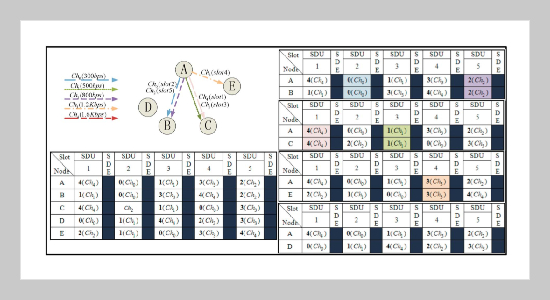REFERENCES
- [1] Ning, Z. L., et al., “A Novel Adaptive Spectrum Allocation Scheme for Multi-channel Multi-radio Wireless Mesh Networks,” Journal of Network and Computer Applications, Vol. 56, pp. 19�27 (2015). doi: 10.1016/ j.jnca.2015.06.004
- [2] Ren, P., “Manufacturing Sensor Network Based on Multi-radio and Multi-Channel,” Antennas and Propagation (APCAP), 2014 3rd Asia-Pacific Conference on. IEEE (2014). doi: 10.1109/APCAP.2014.6992626
- [3] Wei, P., et al., “Distributed Adaptive Channel Allocation in Multi-radio Wireless Sensor Networks,” Journal of Communications, Vol. 11, No. 11, pp. 984�991 (2016). doi: 10.12720/jcm.11.11.984-991
- [4] Saifullah, et al., “Distributed Channel Allocation Protocols for Wireless Sensor Networks,” IEEE Transactions on Paralleland Distributed Systems, Vol. 25, No. 9, pp. 2264�2274 (2014). doi: 10.1109/TPDS.2013. 185
- [5] Alicherry, Mansoor, et al., “Joint Channel Assignment and Routing for throughput Optimization in Multi-radio WirelessMeshNetworks,” Proceedings of the11th Annual International Conference on Mobile Computing and Networking, ACM (2005). doi: 10.1145/ 1080829.1080836
- [6] Das, Arindam K., et al., “WLC30-4: Static Channel Assignment in Multi-radio Multi-channel 802.11 Wireless Mesh Networks: Issues, Metrics and Algorithms,” Global Telecommunications Conference, 2006. GLOBECOM’06.IEEE (2006). doi: 10.1109/GLOCOM. 2006.790
- [7] Wang, W., et al., “Interference-aware Joint Routing and TDMA Link Scheduling for Static Wireless Networks,” IEEE Transactions on Parallel and Distributed Systems, Vol. 19, No. 12, pp. 1709–1726 (2008). doi: 10.1109/TPDS.2008.53
- [8] Marina, Mahesh K., et al., “A Topology Control Approach for Utilizing Multiple Channels in Multi-radio Wireless Mesh Networks,” Computer Networks, Vol. 54, No. 2, pp. 241�256 (2010). doi: 10.1016/j.comnet. 2009.05.015
- [9] Komali,etal., “Analyzing Selfish Topology Control in Multi-radio Multi-channel Multi-hop Wireless Networks,” Communications, 2009. ICC’09.IEEE International Conference on IEEE (2009). doi: 10.1109/ ICC.2009.5198750
- [10] Felegyhazi, Mark, et al., “Non-cooperative Multi-radio Channel Allocation in Wireless Networks,” INFOCOM 2007. 26th IEEE International Conference on Computer Communications. IEEE (2007). doi: 10. 1109/INFCOM.2007.170
- [11] Chen, J. M., et al., “Game Theoretical Approach for Channel Allocation in Wireless Sensor and Actuator Networks,” IEEE Transactions on Automatic Control, Vol. 56, No. 10, pp. 2332�2344 (2011). doi: 10.1109/ TAC.2011.2164014
- [12] Subramanian, Anand Prabhu, et al., “Minimum Interference Channel Assignment in Multiradio Wireless Mesh Networks,” IEEE Transactions on Mobile Computing, Vol. 7, No. 12, pp. 1459�1473 (2008). doi: 10. 1109/TMC.2008.70
- [13] Ding, Y. and Li, X., “Channel Allocation in Multichannel Wireless Mesh Networks,” Computer Communications, Vol. 34, No. 7, pp. 803�815 (2011). doi: 10.1016/j.comcom.2010.10.011
- [14] Lin, T. Y., et al., “Channel-hopping Scheme and Channel-diverse Routing in Static Multi-radio Multi-hop WirelessNetworks,” IEEETransactionsonComputers, Vol. 64, No. 1, pp. 71�86 (2015). doi: 10.1109/TC. 2013.199
- [15] Kyasanur, Pradeep, and Vaidya, Nitin, H., “Routing and Link-layer Protocols for Multi-channel Multi-interface Ad Hoc Wireless Networks,” ACM SIGMOBILE Mobile Computing and Communications Review, Vol. 10, No. 1, pp. 31�43 (2006). doi: 10.1145/1119759. 1119762
- [16] Di Felice, et al., “Future Channel Reservation Medium Access Control (FCR-MAC) Protocol for Multi-radio Multi-channel Wireless Mesh Networks,” Proceedings of the 5th ACM Symposium on Performance Evaluation of Wireless Ad Hoc, Sensor, and Ubiquitous Networks, ACM (2008). doi: 10.1145/1454609. 1454625
- [17] Huang, R.S., etal.,“SAM-MAC:anEfficientChannel Assignment Scheme for Multi-channel Ad Hoc Networks,” Computer Networks,Vol.52, No. 8, pp. 1634� 1646 (2008). doi: 10.1016/j.comnet.2008.02.004
- [18] So, W., et al., “McMAC: a Parallel Rendezvous Multichannel MAC Protocol,” Wireless Communications and Networking Conference, 2007. WCNC 2007. IEEE.IEEE (2007). doi: 10.1109/WCNC.2007.67
- [19] Lee, W. J., etal., “An EfficientMulti-channel Management Protocol for Wireless Body Area Networks,” Information Networking, 2009. ICOIN 2009. International Conference on. IEEE (2009).
- [20] Cormio, et al., “Common Control Channel Design for Cognitive Radio Wireless Ad Hoc Networks Using Adaptive Frequency Hopping,” Ad Hoc Networks, Vol. 8, No. 4, pp. 430�438 (2010). doi: 10.1016/j.adhoc.
2009.10.004
- [21] Liu, Z. W. and Wei, W., “A Dynamic Multi-radio Multi-channelMACProtocol for WirelessSensor Networks,” Communication Software and Networks, 2010. ICCSN’10. Second International Conference on. IEEE (2010). doi: 10.1109/ICCSN.2010.19
- [22] Klingler, Florian, et al., “MCB–A Multi-Channel Beaconing Protocol,” Ad Hoc Networks, Vol. 36, pp. 258�269 (2016). doi: 10.1016/j.adhoc.2015.08.002
- [23] Prasad Joshi, et al., “Adaptive Window Size-based Medium Access Control Protocol for Cognitive Radio Wireless Sensor Networks,” Journal of Sensors, (2016). doi: 10.1155/2016/2049859
- [24] Yang, B., et al., “A Time-efficient Rendezvous Algorithm with a Full Rendezvous Degree for Heterogeneous Cognitive Radio Networks,” IEEE INFOCOM 2016, 35th Annual IEEE International Conference on Computer Communications (2016). doi: 10.1109/ INFOCOM. 2016.7524556
- [25] Bahl, Paramvir, et al., “SSCH: Slotted Seeded Channel Hopping for Capacity Improvement in IEEE 802.11 Ad-hoc Wireless Networks,” Proceedings of the 10th Annual International Conference on Mobile Computing and Networking, ACM (2004).
- [26] Yang, B., et al., “Fully Distributed Channel-hopping Algorithms for Rendezvous Setup in Cognitive Multiradio Networks,” IEEE Transactions on Vehicular Technology, Vol. 65, No. 10, pp. 8629�8643 (2016). doi: 10.1109/TVT.2015.2510359
- [27] Chao, C. M., et al., “A Fast Rendezvous-guarantee Channel Hopping Protocol for Cognitive Radio Networks,” IEEE Transactions on Vehicular Technology, Vol. 64, No. 12, pp. 5804�5816 (2015). doi: 10.1109/ TVT.2014.2387377
- [28] Chang, G. Y., et al. “Novel Channel-hopping Schemes for CognitiveRadioNetworks,” IEEETransactions on Mobile Computing, Vol. 13, No. 2, pp. 407�421 (2014). doi: 10.1109/TMC.2012.260
- [29] Römer, Kay, Philipp Blum and Lennart Meier, “Time Synchronization and Calibration in Wireless Sensor Networks,” Handbook of Sensor Networks: Algorithms and Architectures, Vol. 49, p. 199 (2005). doi: 10.1002/047174414X.ch7
- [30] So, H. S., et al., “Practical Synchronization Techniques for Multi-channel MAC,” Proceedings of the 12th Annual International Conference on Mobile Computing and Networking, ACM (2006). doi: 10.1145/ 1161089.1161105
- [31] Zeng, X., et al., “GloMoSim: a Library for Parallel Simulation of Large-scale Wireless Networks,” Parallel and Distributed Simulation, 1998. PADS 98. Proceedings. Twelfth Workshop on. IEEE (1998). doi: 10.1109/PADS.1998.685281
- [32] Howie, J. M., Fields and Galois Theory [electronic resource], Springer-Verlag London Limited (2006). [33] Zepernick, et al., Pseudo Random Signal Processing: Theory and Application, John Wiley & Sons (2013). [34] MATLAB, http://www.mathworks.cn/.









